Bond enthalpies - Study guides, Class notes & Summaries
Looking for the best study guides, study notes and summaries about Bond enthalpies? On this page you'll find 72 study documents about Bond enthalpies.
Page 2 out of 72 results
Sort by
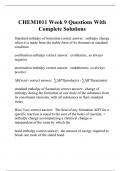
-
CHEM1011 Week 9 Questions With Complete Solutions
- Exam (elaborations) • 3 pages • 2023
-
- $7.99
- + learn more
Standard enthalpy of formation correct answer: enthalpy change when it is made from the stable form of its elements at standard condition combustion enthalpy correct answer: exothermic, so always negative atomisation enthalpy correct answer: endothermic, so always positive ∆H(rxn)= correct answer: ∑∆Hºf(products) - ∑∆Hºf(reactants) standard enthalpy of formation correct answer: change of enthalpy during the formation of one mole of the substance from its constituent ...

-
General Chemistry ACS EXAM (2015 version) 60 Questions with Verified Answers,100% CORRECT
- Exam (elaborations) • 16 pages • 2024
-
- $10.99
- + learn more
General Chemistry ACS EXAM (2015 version) 60 Questions with Verified Answers A 20.0 g sample of mercury(II) oxide (HgO, M = 216.6) is heated strongly, causing it to decompose to metallic Hg and O2 gas. What volume of O2 gas is produced (measured at STP)? (A) 1.03 L (B) 2.07 L (C) 4.14 L (D) 14.0 L - CORRECT ANSWER A When 30.0 mL of 0.10 M AgNO3 is added to 30.0 mL of 0.10 M NaCl, aqueous NaNO3 and solid AgCl are formed. How much solid AgCl is produced? (A) 0.0030 mol (B) 0.0...
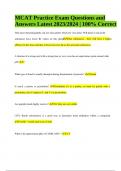
-
MCAT Practice Exam Questions and Answers Latest 2023/2024 | 100% Correc
- Exam (elaborations) • 19 pages • 2023
-
- $18.49
- + learn more
MCAT Practice Exam Questions and Answers Latest 2023/2024 | 100% Correct. Thin layer chromatography can use silica plates which are very polar. Will polar or non polar substances have lower Rf values on this plate? Polar substances - they will have a higher affinity for the silica and thus will not travel as far as the non polar substances A titration of a strong acid with a strong base or vice versa has an equivalence point around what pH? 7 What type of bond is usually disrupted during de...
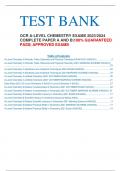
-
TEST BANK OCR A-LEVEL CHEMESTRY EXAMS 2023/2024 COMPLETE PAPER A AND B|100% GUARANTEED PASS| APPROVED EXAMS
- Exam (elaborations) • 309 pages • 2024
-
- $25.39
- + learn more
Answer all the questions. 1 Which statement describes electronegativity? A A measure of the reactivity of an element. B The ability of an atom to attract an electron to become a 1– ion. C The attraction of a bonded atom for the electrons in a covalent bond. D The attraction of an atom for a lone pair of electrons. Your answer [1] 2 A chlorate(VII) ion has a 1– charge. What is the formula for sodium chlorate(VII)? A NaCl O3 B NaCl O4 C NaCl O7 D NaCl O8 ...
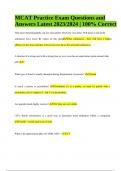
-
MCAT Exam Practice Questions With Answers Latest Updated 2024 (100% Verified)
- Exam (elaborations) • 19 pages • 2024
-
- $15.49
- + learn more
MCAT Exam Practice Questions With Answers Latest Updated 2024 (100% Verified) Thin layer chromatography can use silica plates which are very polar. Will polar or non polar substances have lower Rf values on this plate? Polar substances - they will have a higher affinity for the silica and thus will not travel as far as the non polar substances A titration of a strong acid with a strong base or vice versa has an equivalence point around what pH? 7 What type of bond is usually disrupted duri...
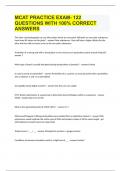
-
MCAT PRACTICE EXAM- 122 QUESTIONS WITH 100% CORRECT ANSWERS.
- Exam (elaborations) • 13 pages • 2023
- Available in package deal
-
- $15.49
- + learn more
Thin layer chromatography can use silica plates which are very polar. Will polar or non polar substances have lower Rf values on this plate? Polar substances - they will have a higher affinity for the silica and thus will not travel as far as the non polar substances A titration of a strong acid with a strong base or vice versa has an equivalence point around what pH? 7 Brainpower Read More 0:06 / 0:15 What type of bond is usually disrupted during denaturation of proteins? ...

-
CHEM 102 Thermodynamics Exam Questions and Answers
- Exam (elaborations) • 2 pages • 2024
- Available in package deal
-
- $7.99
- + learn more
First law of thermodynamics - ANSWER-- the total energy of the universe is constant - energy is only converted from one form to another; cannot be created or destroyed - law of conservation of energy Energy - ANSWER-the capacity to do work or produce heat calorimetry - ANSWER-isolated system where no energy or matter is exchanged with the surroundings; it is used to measure heat absorbed/released in a reaction What does the heat absorbed/released depends on? - ANSWER-1. how exothermic...
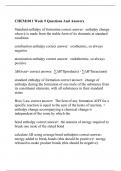
-
CHEM1011 Week 9 Questions And Answers
- Exam (elaborations) • 3 pages • 2023
- Available in package deal
-
- $10.49
- + learn more
Standard enthalpy of formation correct answer: enthalpy change when it is made from the stable form of its elements at standard condition combustion enthalpy correct answer: exothermic, so always negative atomisation enthalpy correct answer: endothermic, so always positive ∆H(rxn)= correct answer: ∑∆Hºf(products) - ∑∆Hºf(reactants) standard enthalpy of formation correct answer: change of enthalpy during the formation of one mole of the substance from its constituent ...
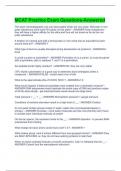
-
MCAT Practice Exam Questions-Answered
- Exam (elaborations) • 10 pages • 2023
-
- $10.99
- + learn more
Thin layer chromatography can use silica plates which are very polar. Will polar or non polar substances have lower Rf values on this plate? - ANSWER-Polar substances - they will have a higher affinity for the silica and thus will not travel as far as the non polar substances A titration of a strong acid with a strong base or vice versa has an equivalence point around what pH? - ANSWER-7 What type of bond is usually disrupted during denaturation of proteins? - ANSWER-H bond Is uracil a ...
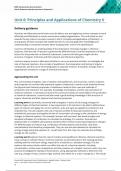
-
APPLIED SCIENCE UNIT 6: PRINCIPLES AND APPLICATIONS OF CHEMISTRY II
- Exam (elaborations) • 14 pages • 2024
-
- $10.99
- + learn more
Unit 6: Principles and Applications of Chemistry II Delivery guidance Scientists and laboratory technicians must be able to use and apply key science concepts to work efficiently and effectively in science and science-related organisations. This unit builds on and extends the key science concepts covered in Unit 2: Principles and Applications of Chemistry I. A strong grasp of these concepts will enable learners to use and apply their knowledge and understanding in vocational contexts...

How did he do that? By selling his study resources on Stuvia. Try it yourself! Discover all about earning on Stuvia


